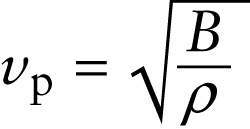Speed of a longitudinal wave in a fluid (13-11)
Question
Density of the fluid
{"title":"Propagation speed of a longitudinal wave in a fluid","description":"Incorrect","type":"incorrect","color":"#99CCFF","code":"[{\"shape\":\"poly\",\"coords\":\"82,133\"},{\"shape\":\"rect\",\"coords\":\"10,16,12,16\"},{\"shape\":\"rect\",\"coords\":\"3,51,28,85\"}]"} {"title":"Bulk modulus of the fluid","description":"Wrong","type":"incorrect","color":"#993300","code":"[{\"shape\":\"rect\",\"coords\":\"187,9,226,57\"}]"} {"title":"Density of the fluid ","description":"Correct!","type":"correct","color":"#333300","code":"[{\"shape\":\"rect\",\"coords\":\"180,79,219,128\"}]"}Review
Just as for a transverse wave on a rope, the speed of a longitudinal wave in a medium depends on the restoring force and the inertia of the medium. For a longitudinal wave in a fluid (a gas or a liquid), we call a longitudinal wave a sound wave. The disturbance associated with the wave corresponds to changes in the pressure of the fluid. We saw in Section 9-4 that the bulk modulus B of a material is a measure of how it responds to pressure changes. A larger bulk modulus means the material is more difficult to compress, which means that it has a greater tendency to return to its original volume when the pressure is released. In \perpher words, the value of B tells us about the restoring force that acts within a fluid when disturbed by the pressure changes associated with a longitudinal wave. A measure of the inertia of the material is its density ρ, equal to its mass per volume (see Example 13-3 above). A detailed analysis using Newton’s laws shows that the speed of sound waves in a fluid is
If we take both restoring force and inertia into account, we find that the propagation speed vp of a transverse wave on a rope is

The greater the bulk modulus B, the faster the propagation speed; the greater the density ρ, the slower the propagation speed.
